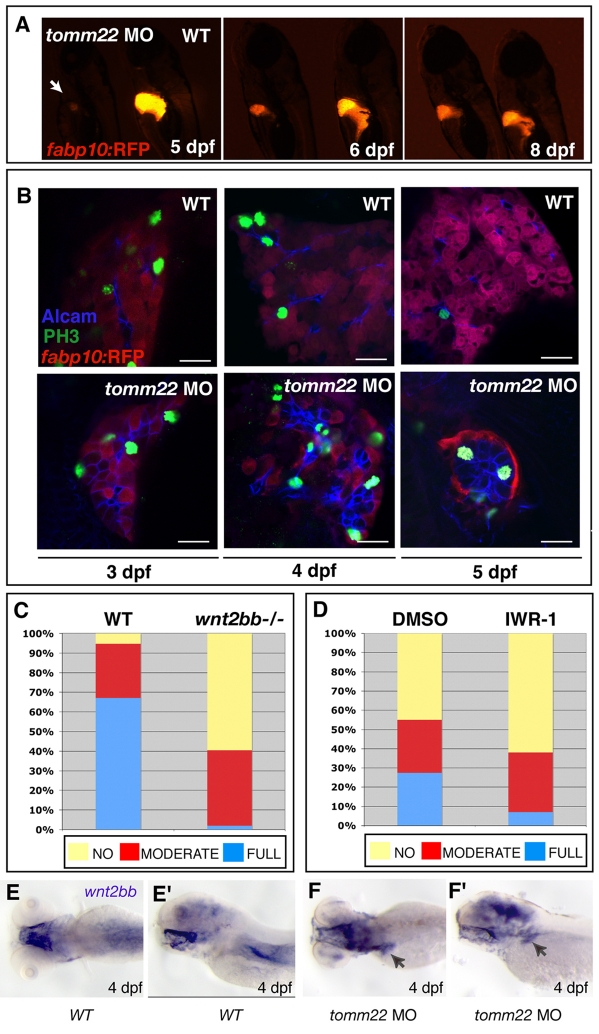Fig. 4.
tomm22 MO provides a model to study liver regeneration and uncovers an involvement of the Wnt2b signaling pathway. (A) Fluorescence images of 5-, 6- and 8-dpf (left, middle and right images, respectively) Tg(fabp10:RFP)gz12 larvae injected with 4 ng of tomm22 MO (left side of each image) and uninjected control larvae (right side of each image). At 5 dpf, tomm22 morphants show a smaller liver (arrow); as the tomm22 MO is diluted and Tomm22 levels recover, the tomm22 morphant livers start recovering their size and structure, which is already obvious at 6 dpf, and are comparable to uninjected controls at 8 dpf. (B) Confocal images of the livers of Tg(fabp10:RFP)gz12WT (top) and tomm22 MO-injected (bottom) larvae at 3, 4 and 5 dpf (left, middle and right panels, respectively) stained for PH3 (green) and Alcam (blue); hepatocytes are stained red. Cellular proliferation occurs at a higher rate in post-ablated livers compared with WT livers. Bars, 20 μm. (C) Comparison of hepatic recovery post-tomm22 MO-mediated ablation in the WT (left bar, n=41) versus wnt2bb−/− (right bar, n=42) background. tomm22 morphants, which at 4 dpf showed severe hepatic ablation, were allowed to recover and at 6 dpf their liver recovery was classified as (1) ‘no’ change in liver size, (2) ‘moderate’ recovery of hepatic volume, or (3) ‘full’ recovery, i.e. comparable to that observed at 6 dpf in most WT larvae injected with 4 ng of tomm22 MO. In the absence of wnt2bb function, ‘full’ recovery (blue) decreased from 67.1% to 1.9%. Conversely, ‘no’ recovery (yellow) increased from 5.2% in WT larvae to 59.5% in wnt2bb−/− larvae. ‘Moderate’ recovery changed from 27.7% in WT larvae to 38.6% in wnt2bb−/− larvae. (D) Comparison of hepatic recovery post-tomm22 MO-mediated ablation in larvae that were allowed to recover in carrier solution (DMSO; left bar, n=73) compared with in the presence of 5 μM of the Wnt–β-catenin pathway inhibitor IWR-1 (right bar, n=82). Recovery rates were classified as in C. In the presence of the Wnt–β-catenin pathway inhibitor IWR-1, ‘full’ recovery decreased compared with DMSO (from 27.5% to 7%), whereas the ‘no’ recovery rate increased from 45% (DMSO) to 62% (5 μM IWR-1). No clear difference was observed in the ‘moderate’ recovery category (27.5% to 31%). (E–F’) Expression of wnt2bb in 4-dpf uninjected (E,E’) and tomm22 MO-injected (F,F’) larvae. E and F are dorsal views; E’ and F’ are lateral views. wnt2bb hepatic expression appeared to be upregulated in many 4-dpf tomm22 morphants (n=9/17) (F, F’) compared with uninjected larvae (n=0/17) (E, E’) (similar numbers were observed at 5 dpf).

